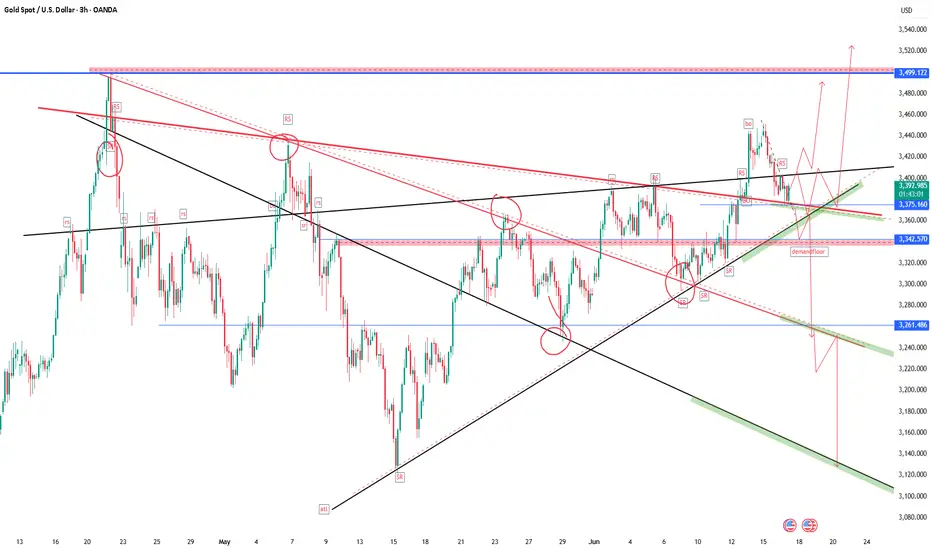The relationship between gold, the 10-year U.S. Treasury bond yield, and interest rates has traditionally been a key focus for investors. Historically, gold prices and bond yields have shown a strong inverse correlation, but recent years have seen some deviations due to shifting macroeconomic and geopolitical dynamics.
1. Gold and 10-Year Bond Yield
Inverse Correlation:
For nearly two decades, gold and the 10-year Treasury yield moved in opposite directions: rising yields made bonds more attractive relative to gold (which pays no interest), causing gold prices to fall, and vice versa.
Recent Divergence:
Since 2022, this relationship has weakened. Despite rising yields, gold prices have remained strong or even increased, largely due to unprecedented central bank gold buying and heightened geopolitical risks.
Current Data:
As of June 16, 2025, the 10-year Treasury yield is approximately 4.46%, up from 4.20% a year ago. Gold prices remain elevated, reflecting persistent demand despite higher yields.
2. Gold and Interest Rates
Opportunity Cost Effect:
Higher interest rates increase the opportunity cost of holding non-yielding gold, typically leading to lower gold prices. When rates fall, gold becomes more attractive, supporting price gains.
Real Interest Rates:
The most relevant metric is the real interest rate (nominal rate minus inflation). Gold’s correlation with real yields is strongly negative (historically around -0.82): when real yields fall or turn negative, gold prices rise as investors seek alternatives to low or negative real returns.
Central Bank Policy:
Expectations of rate cuts by major central banks, such as the Federal Reserve, tend to boost gold prices by lowering real yields and the dollar’s appeal.
Real interest rates (adjusted for inflation) are the most important driver for gold’s price direction.
As of June 2025, the 10-year Treasury yield is 4.46%, with markets watching for potential rate cuts that could further support gold prices.
Conclusion:
While gold traditionally moves opposite to bond yields and interest rates, the relationship has become more complex in 2025. Central bank demand, geopolitical risks, and real interest rates now play a larger role in gold price dynamics alongside traditional monetary policy factors.
1. Gold and 10-Year Bond Yield
Inverse Correlation:
For nearly two decades, gold and the 10-year Treasury yield moved in opposite directions: rising yields made bonds more attractive relative to gold (which pays no interest), causing gold prices to fall, and vice versa.
Recent Divergence:
Since 2022, this relationship has weakened. Despite rising yields, gold prices have remained strong or even increased, largely due to unprecedented central bank gold buying and heightened geopolitical risks.
Current Data:
As of June 16, 2025, the 10-year Treasury yield is approximately 4.46%, up from 4.20% a year ago. Gold prices remain elevated, reflecting persistent demand despite higher yields.
2. Gold and Interest Rates
Opportunity Cost Effect:
Higher interest rates increase the opportunity cost of holding non-yielding gold, typically leading to lower gold prices. When rates fall, gold becomes more attractive, supporting price gains.
Real Interest Rates:
The most relevant metric is the real interest rate (nominal rate minus inflation). Gold’s correlation with real yields is strongly negative (historically around -0.82): when real yields fall or turn negative, gold prices rise as investors seek alternatives to low or negative real returns.
Central Bank Policy:
Expectations of rate cuts by major central banks, such as the Federal Reserve, tend to boost gold prices by lowering real yields and the dollar’s appeal.
Real interest rates (adjusted for inflation) are the most important driver for gold’s price direction.
As of June 2025, the 10-year Treasury yield is 4.46%, with markets watching for potential rate cuts that could further support gold prices.
Conclusion:
While gold traditionally moves opposite to bond yields and interest rates, the relationship has become more complex in 2025. Central bank demand, geopolitical risks, and real interest rates now play a larger role in gold price dynamics alongside traditional monetary policy factors.
Disclaimer
The information and publications are not meant to be, and do not constitute, financial, investment, trading, or other types of advice or recommendations supplied or endorsed by TradingView. Read more in the Terms of Use.
Disclaimer
The information and publications are not meant to be, and do not constitute, financial, investment, trading, or other types of advice or recommendations supplied or endorsed by TradingView. Read more in the Terms of Use.
